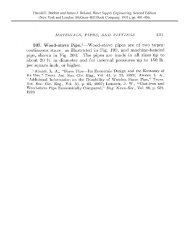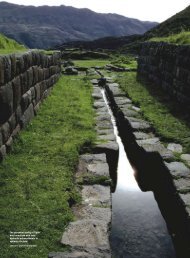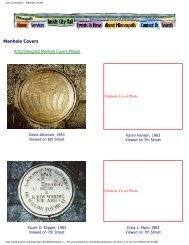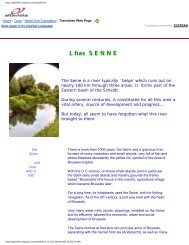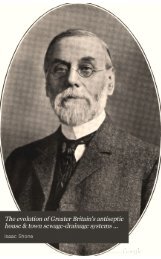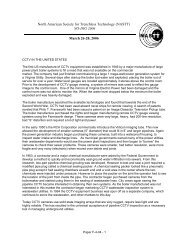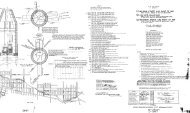The Water Supply and Distribution System of the Nabataean City of ...
The Water Supply and Distribution System of the Nabataean City of ...
The Water Supply and Distribution System of the Nabataean City of ...
Create successful ePaper yourself
Turn your PDF publications into a flip-book with our unique Google optimized e-Paper software.
may have found use in later hydraulic planning by <strong>the</strong><br />
<strong>Nabataean</strong>s — particularly to match spring flow rates<br />
with piping flow rate capacity.<br />
<strong>Nabataean</strong> overall water-system design strategy<br />
Early use <strong>of</strong> spring-fed pipelines in Hellenistic cities<br />
<strong>of</strong> Ionia, mainl<strong>and</strong> Greece <strong>and</strong> <strong>the</strong> Greek colonies<br />
(Crouch 1993) <strong>and</strong> in contemporary Roman cities indicates<br />
that pipeline technology was well developed<br />
in many parts <strong>of</strong> <strong>the</strong> ancient world <strong>and</strong> was available<br />
for assimilation into <strong>Nabataean</strong> water system.<br />
<strong>The</strong> <strong>Nabataean</strong> systems, however, are unique in that<br />
water conservation is practiced on a much larger scale<br />
<strong>and</strong> intermittent supplies from seasonal rainfall were<br />
exploited to sustain <strong>the</strong> city through dry seasons. In essence,<br />
<strong>the</strong> <strong>Nabataean</strong>s utilized all possible above-<strong>and</strong>-below<br />
ground water supply <strong>and</strong> storage methodologies simultaneously.<br />
While water storage in contemporary Hellenistic<br />
cities also emphasized cisterns for household use, <strong>the</strong><br />
Petra systems advanced this technology to citywide<br />
systems with elaborate dams <strong>and</strong> cisterns that served<br />
both water storage <strong>and</strong> flood control purposes. <strong>Water</strong><br />
storage in aquifers was promoted through dams; this<br />
allowed for use <strong>of</strong> wells as a backup system should all<br />
o<strong>the</strong>r supplies fail. Provided a cistern could be made<br />
deep enough, it would be resupplied from groundwater,<br />
a technique well known in Bronze <strong>and</strong> Iron Age<br />
cities <strong>of</strong> <strong>the</strong> Near East.<br />
Summary <strong>and</strong> conclusions<br />
A comprehensive water-supply system <strong>of</strong> dams,<br />
cisterns, channels <strong>and</strong> pipelines exploited springs as<br />
well as rainfall run<strong>of</strong>f. While some <strong>of</strong> <strong>the</strong> technology<br />
must have been borrowed from contemporary cities,<br />
<strong>the</strong> limited water resources at Petra, combined<br />
with <strong>the</strong> complex topography led to innovations in<br />
<strong>the</strong> use <strong>of</strong> water-storage methodologies on a citywide<br />
scale where stored run<strong>of</strong>f water provided a sizeable<br />
fraction <strong>of</strong> yearly requirements <strong>and</strong> served as<br />
a backup to <strong>the</strong> many springs. Examination <strong>of</strong> two<br />
different pipeline systems with very different slopes<br />
<strong>and</strong> delivery requirements (one on-dem<strong>and</strong> <strong>and</strong> <strong>the</strong><br />
o<strong>the</strong>r continuous flow) indicates that technology (<strong>and</strong><br />
experience to employ it) was in place to provide different<br />
designs that minimized leakage, maximized <strong>the</strong><br />
flow rate, minimized particle ingestion <strong>and</strong> clogging<br />
<strong>and</strong> eliminated transient flow instabilities. <strong>The</strong> Siq<br />
pipeline incorporated water purification by means <strong>of</strong><br />
four well-placed settling basins which also solved a<br />
complex flow stability problem. <strong>The</strong> range <strong>of</strong> solutions<br />
adopted confirms that a hydraulic design methodol-<br />
Charles R. Ortl<strong>of</strong>f<br />
108<br />
ogy was in place <strong>and</strong> was applied with great cognitive<br />
skill to solve complex hydraulic problems.<br />
It is traditional to look for Roman technical advances<br />
that improved <strong>the</strong> <strong>Nabataean</strong> system, but few<br />
are found. This indicates that Roman engineers may<br />
have viewed <strong>the</strong> <strong>Nabataean</strong> system as near-optimum.<br />
In that case, it is likely that <strong>the</strong> several water-management<br />
techniques observed by <strong>the</strong> Romans may<br />
have been borrowed by <strong>the</strong>m <strong>and</strong> applied to <strong>the</strong>ir<br />
desert cities <strong>and</strong> outposts. It is clear that <strong>the</strong> success<br />
<strong>and</strong> longevity <strong>of</strong> Petra depended upon its innovative<br />
water-system design which in itself constitutes a vital<br />
chapter in <strong>the</strong> history <strong>of</strong> water management in <strong>the</strong><br />
ancient Near East.<br />
References<br />
C.R. Ortl<strong>of</strong>f<br />
CTC/United Defense<br />
Santa Clara, CA 95050<br />
USA<br />
Email: Charles.Ortl<strong>of</strong>f@udlp.com<br />
Akasheh, T., 2003. <strong>Nabataean</strong> <strong>and</strong> modern watershed management<br />
around <strong>the</strong> Siq <strong>and</strong> Wadi Mousa in Petra,<br />
in Hashemite University Report, <strong>The</strong> Hashemite University,<br />
Zarqa, Jordan. Zarqa: Hashemite University<br />
Press, 1–15.<br />
Auge, C. & J. Denzer, 2000. Petra, Lost <strong>City</strong> <strong>of</strong> <strong>the</strong> Ancient<br />
World. New York (NY): H. Abrams, Inc. Publishers.<br />
Bedal, A., 2004. <strong>The</strong> Petra Pool-Complex: a Hellenistic Paradeisos<br />
in <strong>the</strong> <strong>Nabataean</strong> Capital. Piscataway (NJ): Gorgias<br />
Press.<br />
Bourbon, F., 1999. Petra, Art, History <strong>and</strong> Itineraries in <strong>the</strong><br />
<strong>Nabataean</strong> Capital. Rome: Grafedit Publishers.<br />
Bowersock, G., 1983. Roman Arabia. Cambridge (MA): Harvard<br />
University Press.<br />
Browning, I., 1982. Petra. London: Chatto & Windus Publishers.<br />
Butterfield, R., 1964. Ancient Rome. New York (NY): Odyssey<br />
Press.<br />
Cary, A., L. Weinstein & D. Bushnell, 1980. Viscous flow<br />
drag reduction, in Drag Reduction Characteristics <strong>of</strong><br />
Small Amplitude Rigid Surface Waves. (AIAA Progress<br />
in Astronautics <strong>and</strong> Astronautics 72.) New York (NY):<br />
American Institute <strong>of</strong> Aeronautics <strong>and</strong> Astronautics,<br />
144–67.<br />
Cohen, M. & I. Drabkin, 1966. A Sourcebook in Greek Science.<br />
Cambridge (MA): Harvard University Press, 336–42.<br />
Crouch, D., 1993. <strong>Water</strong> Management in Ancient Greek Cities.<br />
Oxford: Oxford University Press.<br />
Flow Science Inc., 2003. Flow Science User’s Manual. Santa Fe<br />
(NM): Flow Science, Inc.<br />
Glueck, N., 1959. Rivers in <strong>the</strong> Desert. New York (NY): Straus<br />
<strong>and</strong> Cudahy Publishers.<br />
Glueck, N., 1965. Deities <strong>and</strong> Dolphins. New York (NY):




